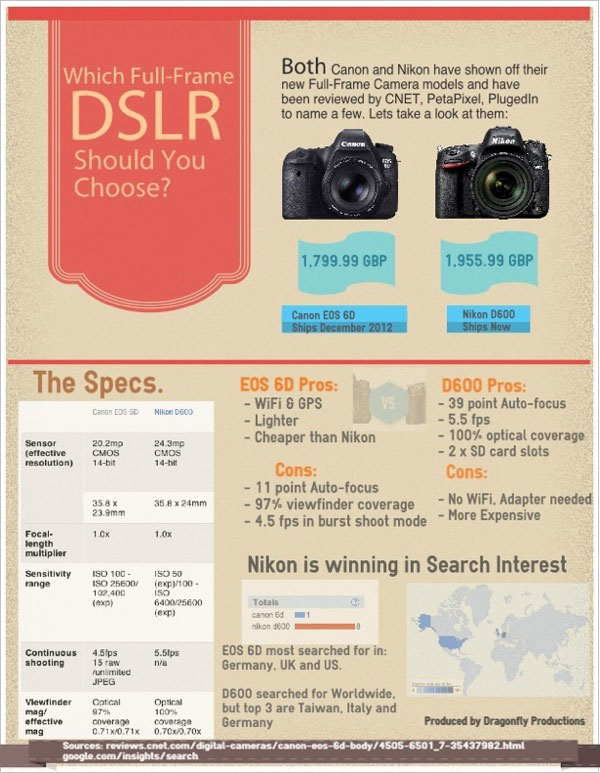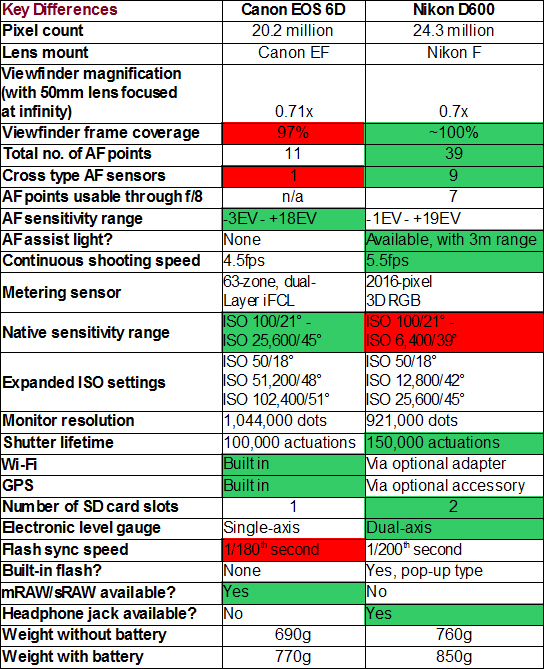There is a lot of talk on the Web regarding the similarities and differences between the new Nikon and Canon entry-level full-frame cameras. For a starter, they even have nearly the same name… If you’re in the market for a full-frame sensor that’s about one third less expensive than the D800 and 5D Mark III, which one to go for?
We can’t reinvent the wheel, so we list a selection of the best comparisons found on the Net. Preliminary bottom line: the Nikon seems to offer the more decent AF system, the Canon built-in GPS and Wi-Fi. For everything on the Nikon read our dedicated The Nikon D600 File, for everything on the Canon The Canon EOS 6D File.
Which one will it be?
Michael Andrew posts the “Nikon D600 vs. Canon 6D Epic Shootout Comparison” (BTW, very much worth seeing in 1080p HD!):
The age old question every time Nikon and Canon put out a similar camera is which one should you buy, says Fro. He’d go with the Nikon:
Natural Exposures have a nice video comparison:
DigitalRev has a go at the Nikon vs. the Canon. Who wins?
Dragonfly has the “full-frame face-off”: Nikon D600 vs. Canon 6D: They doubt that either would provoke a someone to switch brands and the truth is that the release of these cameras bodes well for both professional and amateur photographers. Check out the infographic to see a more detailed comparison:

DigitalReviewCanada‘s comparison goes into many details. Conclusion:
The Nikon D600 and the Canon EOS 6D are both very intriguing full-frame digital SLR cameras in their own right. Clearly Nikon and Canon have taken a different design approach to their new “entry-level” full-frame digital SLR’s.
Nikon has adopted a top down approach with respect to the Nikon D600 FX format SLR, by electing to include many of the same technologies and advanced features found in the higher-end Nikon D800 and D4 SLR cameras. With 24.3MP resolution, the Nikon D600 FX format SLR features the highest resolution of any camera currently in its class. Designed as a serious tool for the photo enthusiast and as a working backup for professionals, the Nikon D600 is a very capable performer in all areas.
The Nikon D600 SLR camera’s DX crop format mode with its 1.5x cropped (FOV) focal multiplier effect will be welcomed by especially sports action and wildlife photographers, and others that have come to appreciate the benefits of shooting in the DX (APS-C) format.
Taking into account its product positioning in the Nikon digital SLR line-up, there is not much that can be said to be missing from the Nikon D600 SLR.
It is interesting to see that Canon has chosen to take a different approach and rather than delivering higher end features, speed and performance, has designed the full-frame Canon EOS 6D to excel as a low light / high ISO performer, and to cater to bloggers and the active social networking type by incorporating practical features like built-in Wi-Fi transfer and GPS tagging functionality.
From an enthusiast point of view, the Nikon D600 has a lot to offer that the Canon EOS 6D does not. Although the Nikon D600 does not offer built-in Wi-Fi or GPS geotagging, these features can be added to the camera with dedicated optional accessories. In terms of low light photography the Nikon D600 is already a serious performer, and although the Canon EOS 6D may (and more than likely will) excel in this area, the relative advantage to most shooters is in comparison unlikely to outweigh the many other benefits offered by the D600. Die hard low light photographers may disagree.
There is no doubt that Canon’s marketing team certainly has their work cut out for them in the coming months. With the Nikon D600 already earning accolades from photographers, the Canon EOS 6D seems like it will be a bit late to the party.
SuperSafTV provides a good backgrounder:
Says Roman on Mansurovs:
We see a very different situation though when comparing identically priced rivals, the Canon 6D and the Nikon D600. Nikon seems to shine as the better of the two, and by quite a margin. First of all, it offers a more sophisticated 39-point AF system with 9 cross-type sensors, while Canon has given its new camera a somewhat outdated 11-point AF with just one cross-type sensor. While Canon interestingly says it is the most sensitive system of all current EOS cameras and is able to focus down to -3EV, which is very dark, we are yet to see if it’s true. Lets try to stay positive and not assume it will be as inferior to Nikon’s 39-point AF as it seems at first glance.
Canon also loses when comparing resolution. While there’s not much real world, print-noticeable difference between 20 and 24 megapixels, with the launch of 6D, Canon has made clear that there will not be a high-resolution rival to the D800, at least at a similar price point. Due to smaller pixel pitch, high ISO and low light performance should be a little better than that of Nikon D600, but the difference, again, might not be significant. Nikon uses very good sensors that can perform great at the highest sensitivities, as proven by D800, so things might turn out either way — we will make sure to compare them side-by-side thoroughly.
Canon 6D also doesn’t seem to be as fast as Nikon D600 at 4.5 frames per second max (versus 5.5 frames per second D600 offers). More than that, shutter durability has been rated at 100K clicks versus 150K — that’s as low as the old Canon 500D offers, which also cost about three times less at introduction three years ago. Add an inferior viewfinder with 97% coverage and a single SD card slot, lack of pop-up flash (important for some, while some will prefer better sealing), inferior video specifications (which used to be Canon’s playground — now Nikon offers uncompressed video via HDMI), and you’ve got a camera that should have either been launched a year ago (at least), or priced lower. The only real advantages (and, to be fair, modern, should-be-standard features) 6D offers are built-in GPS and Wi-Fi functionality. It’s almost as if Canon either wasn’t trying, or wasn’t expecting Nikon to launch the D600. If the latter is the case, they missed, as many have said before me, the worst kept secret in the history of DSLRs.
Feature for feature, Reviewed.com has the D600 and 6D match up. Early conclusion:
Though we’ve spent quite lot of words here trying to show how different they are, the similarities between these two $2,100 full-frame cameras certainly outnumber the differences. They offer practically identical specifications, features and designs, and at least on paper they present incredibly similar value propositions. To choose between them as a neutral observer involves splitting quite a few hairs.
The Nikon has the clear advantage in speed and autofocus functionality, but suffers with regard to low-light sensitivity. The Canon body didn’t feel as nice as we were hoping, based on our time with the Canon 7D and 5D Mark III, but it offered far better single-handed control. The Nikon also offers dual SD card slots, compared to just one on the Canon.
Altogether, we found that they both succeeded the same singular mission: making us wish we owned one. The Sony A850 may have been the first to break the sub-$2000 barrier for full-frame bodies, but the Canon EOS 6D and Nikon D600 are paving new ground with impressive technology at a reasonable price.
Even after our hands-on impressions and ample time spent studying spec sheets, we still can’t declare a clear winner between these two. The Nikon D600 appears to have an edge in RAW features and hardware, but we prefer the Canon 6D’s more ergonomic and convenient control scheme.
Fashion photographer Benjamin Karanek is thinking about buying either one. He considers digital a disposable medium, so he will not spend a fortune on a camera that will become obsolete soon.
His reasons to buy the Nikon…
… and the Canon:
TechRadar on the full-frame DSLR battle:
Pitching the Canon EOS 6D and Nikon D600 against each other is something many consumers are bound to do, but actually, when you examine the cameras a little more thoroughly, they are in fact fairly different propositions.
Aside from the fact that both cameras are full-frame, there are benefits to both systems. However, on paper at least, the Nikon D600 seems to offer the better package, even if it does cost a little more money for the moment.
Nikon users see a more advanced camera, with the greater number of AF points, clean HDMI output and 100% viewfinder coverage. The Nikon D600 is likely to appeal both to newcomers to full-frame cameras and those looking for a second camera in a Nikon D800 or D4 setup.
On the other hand, the Canon EOS 6D is arguably more beginner friendly, especially with the inbuilt Wi-Fi functionality. The 11 autofocus points may seem a little low compared with the many points offered by other cameras, but it is perhaps a little less intimidating to a new user.
It goes without saying that those with a stack of full-frame compatible lenses will no doubt be drawn towards whichever brand they started with. However, those fresher to the market face a more difficult decision that will likely be based on whichever features are more personally appealing.
Here’s Photography Blog on the key differences. Check the handy little table. Looks like the Nikon is better in almost every way:

Dan Carr takes a look at the defining specs of both these cameras and then talks though them in a bit more detail. Conclusion:
Neither of these camera stands out as one that would make someone switch camps though. If one had come out and not the other then I would be saying a different thing because a full-frame camera at this price point is a huge milestone. But with both the big guys unwrapping these just days apart then you can stay loyal to your current lens collection and be happy with either.
My overall impression though is that Nikon in particular have done a great job. They were not shy about including features in the D600 that are also in the D800.


